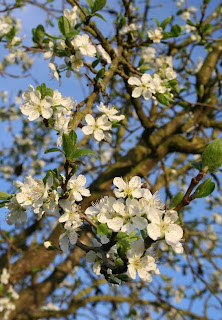
The plum tree and the damsons are in flower, the Pulsatillas are ablaze on the scree bed and we spotted the first swallows further up the lane last night. The days are mild, the evenings scented and long. It feels like a proper spring.

The mild weather and recent rain have been perfect for mulching. Ewan has been steadily chomping at the huge pile near the entrance, heaving it into the little trailer behind the mower and spreading it ever so delicately through the borders. They look so smart now with their matt black coats, and it sets the herbaceous shoots and bulbs off beautifully. Not only does it look fabulous, but of course it saves us weeks of weeding later in the year as it suppresses the annual weed seed population almost completely. But you know all that, because I’ve said it before. I know, I am a total mulch bore.
There are areas where I’m a bit more sensitive about what I spread on the soil, especially around the Trilliums, Meconopsis and where I’m keeping a more naturalistic, woodland look. These special areas get the finest mulch I know of – home made leafmould. Well, home made, but not home sourced – as our garden doesn’t produce enough leaves to make enough mulch for my voracious demand. I rely on Janet, who gathers up the copious oak and beech leaves from her garden, bags them and lugs her precious cargo here in her car when she comes to work in trip after trip each autumn. I could not be more grateful. When she moves house, as she probably will this year, I’ll have to find a new supply. Sieved, it makes the loveliest, soft, lightweight compost which I mix with our standard peat free to make a woodland pot compost. Unsifted it makes a thick cover, more attractive and a better blanket than uncollected leaves.
One step ahead of the mulching trailer, I’m lifting and dividing perennials to increase clumps and to make babies for the nursery too. Right now, it couldn’t be easier. The soil is light and warm and plants fall apart in my hands. Today was Geranium phaeum ‘Album’, Sinacalia tangutica (yes I know it’s invasive, but I’m always asked for it), Inula hookeri and Arisarum proboscideum. We do buy in a lot of plants at the moment, but the goal is propagation self-sufficiency except for PBR plants. In the ‘Grand Plan’, this year I will completely dig out and replant the old, unruly stock beds. The new beds will be logically organised according to an as yet undevised planting scheme, free of marestail, ground elder and couch grass and managed according to a biennial cycle to ensure a completely sustainable growth and production rate. Well, a girl needs a dream.
But before I really get stuck into bright visions of the future, I need to do a final clear out of victims of the past. I moved hundreds of pots to a quiet spot at the back of the nursery and have left them alone for the past few weeks, giving them one last chance to stir themselves into life, but they are, as I knew all along, as dead as doornails. We probably lost 20% of our over-wintered stock this winter (I know some nurseries lost a lot more). Plants which slept soundly and have bounded happily into life in the open garden rotted and died in their pots on the nursery. The death rate was cruel, random and inexplicable. Geranium pratense types survived, the slow growing (lovely) and velvety leaved G. wlassovianum thrived, 60 Geranium phaems all died. Geranium phaeum! Unbelievable. Aconitum napellus thrived, Aconitum carmichaelii died. Tired of selling out of tiny Brunnera ‘Jack Frost’ each spring, I bought 200 plugs last August to grow on. Confident in their total hardiness, I put the newly potted on plugs outside in late September. The whole lot got wet, froze solid and died. Everything in the polytunnels survived, even though they are unheated with mesh sides and dropped below -10C. But I can keep plants dry in the tunnels. Lessons learned. If it’s in a pot, bring it under cover. (Except Lychnis chalcedonica, which is absolutely, totally, bomb-proof)
And despite upping the insulation and heating in the greenhouse, I have still lost plants – not through cold but through misjudgement. In January, my beautiful, huge leaved, black stemmed Colocasia fontanesii tubers were firm and surely alive. But in late Feb, early March when the sun pushed the temperature in their heated plastic tent into the mid 20’s, I watered them. Big mistake. The moisture and warmth brewed a hot compost stew and rotted the dormant tubers. I should have left them dry until they sprouted. I have been gardening for the past thirty years, professionally for the past four, spend almost all my waking hours with, or thinking about plants and I still mess up big style. Is that depressing or reassuring?
Recent Comments